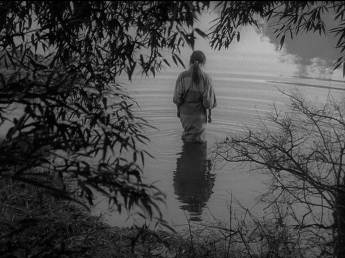When Washington Phillips, probably the greatest of the preacher-troubadours captured in the recording industry’s first flush of Southern gospel fever, begins “Lift Him Up That’s All” with the line, “When Jesus was around here / on this land …” one senses that he’s not kidding. Phillips isn’t singing about Palestine in the time of Christ—he’s singing as if the very dirt beneath his feet still bears Christ’s footprints. It’s a sentiment related to the indelible Mormon conviction that Christ visited America’s shores, but the stress falls on something quite different—not asserting a literal reordering of history but rather claiming a personal, easygoing, intimate, and thoroughly unremarkable relationship with the Son of God, as if he were just another buddy from down the road apiece. This strikes me as a particularly American tendency, not limited to any one denomination—an unpretentious democratic divine.
Spencer Williams’s consistently extraordinary directorial debut, The Blood of Jesus, exhibits this quality with clear-eyed, undiluted devotion. Yet no amount of scholarly attention can ever assimilate this film into the American canon—it’s too ruddy and rough, too incidental and leavening, too small-scaled and magnificent. The morals are commonplace and one-note: a scorn of material things, a condemnation of hot temptation, the consequences of lazy unbelief. Indeed, everything about The Blood of Jesus is second-hand: its actors tired, its refrains repeated, its costumes cheap, its special effects pilfered from other movies and softened through gauze. A magical gunshot in close-up is seemingly achieved through scratching out the emulsion.
The story is simplicity itself: a rural woman (Cathryn Caviness) finds herself at death’s door after her layabout husband (Williams) accidentally discharges his hunting rifle. The local faithful pray over her while a cosmic morality play plays outs: an angel guides her through a ghostly cemetery but satan’s envoy impresses her with a new dress. But all enticements come with a price, in this case the expectation that our heroine with all become a wallet-lifting whore in a basement dance hall.
The Blood of Jesus proved enormously successful on the race film circuit—the black movie theaters, churches, and meeting halls cited by many a progressive white liberal in their day, even as their products remained invisible to the very same commentators—and yet commercial polish is nowhere in evidence. There’s no profit motive in sight, just a film arising from convictions so plain and honest that they require minimal critical clarification. It looks like it was spliced together with sweat alone, if it even passed through human hands in the first place.
We glimpse heaven as a moving diorama, hell as a real-life juke joint. Purgatory is a sunlit garden that looks out upon stock shots of a neon downtown at midnight. These profound dislocations harm neither continuity nor comprehension—each image works on its own terms. Naturally these unearthly places are approximated no better with a million-dollar budget than with the rather limited resources of the Sack Amusement Co. Indeed Williams’s itinerary is exuberantly, ridiculously Christian, finding grace in every craggly dune and valley path.
What, if anything, do we gain by claiming The Blood of Jesus as a piece of American folk art? Would not such a declaration prematurely concede the film’s crudity as a legitimate mark of defining difference, as something that must be ‘excused’ at the outset lest someone charge routine incompetence viz ‘real’ cinema? Williams’s work is markedly more ‘authentic’ than the still-outstanding and not dissimilar Cabin in the Sky but besting M-G-M at verisimilitude was never a very high hurdle.
My inclination to affix this ‘folk art’ label has more to do with how plainly unaccountable The Blood of Jesus is. There is no exposition offered or any symbols to be parsed: we’re invited to witness a spiritual struggle on the most literal level. Late in the film, a cross suddenly materializes in the countryside, marking a fork in the road: HELL in one direction, ZION in the other. Caviness collapses in front of it and her pursuers, angry juke joint patrons with rocks in hand, beg God to allow their stoning to proceed. “But she stole my wallet, Lord!” exclaims one, making Him party not only to prayers but also to personal grievances, timorous excuses, and all manner of half-assed tribulations. Sensing the score, the devil rides away in his rickety pick-up truck as his ad hoc jug band of sin disperses. Soon the eponymous Blood of Jesus drips from the cross.
In other words, The Blood of Jesus aggressively elevates the vernacular, forcing it to take on the character, air, and hayseed grandeur of something rather more mysterious. Like that other great work of American folk art, James Hampton’s Throne of the Third Heaven of the Nations’ Millennium General Assembly, The Blood of Jesus begins with painfully material objects and renders them ineffable, as artifacts outside mortal purposes. It’s about getting to heaven with what you got, in the terms you talk.

No comments:
Post a Comment